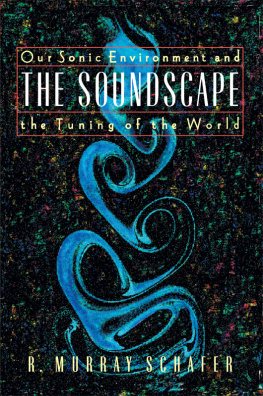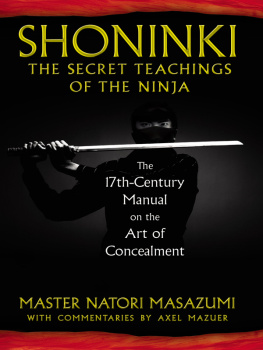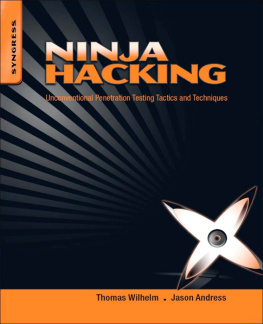

R. MURRAY SCHAFER

Destiny Books
Rochester, Vermont
To my co-workers on
the World Soundscape Project
Preface
Ever since I began studying the acoustic environment, it has been my hope to gather my work together into one book which might serve as a guide for future research. This book accordingly borrows extensively from many of my previous publications, in particular the booklets The New Soundscape and The Book of Noise and the several documents of the World Soundscape Project, especially the essay The Music of the Environment and our first comprehensive field study, The Vancouver Soundscape. But it tries to build this fugitive material into a more careful arrangement.
As evidence has come in from more distant sources and as I have reflected further or been provoked by my fellow researchers, many early assumptions have been revised or abandoned. The present book is as definitive as it can be at the present time, but since only God knows for sure, it must still be regarded as tentative.
Much of the material of this book was revealed through an international study entitled the World Soundscape Project, which many agencies helped to fund. To my immediate co-workers on the Project I owe a great debt of gratitude for countless stimulating meetings and discussions. It is as much their book as it is mine, for they read it, criticized it and provided both facts and encouragement. In particular I wish to thank Hildegard Westerkamp, Howard Broomfield, Bruce Davis, Peter Huse and Barry Truax. Jean Reed, now my wife, was a special help in checking sources, reading numerous drafts and tolerating the many moods of the author.
Numerous scholars in different disciplines have encouraged soundscape studies. Many have read portions of this book and have provided helpful commentaries. Others have suggested new angles of investigation or have sent material from abroad which could not otherwise have been obtained. In particular I wish to thank the following scholars: Professor Kurt Blaukopf and Dr. Desmond Mark of the Institute for Music, Dance and Theatre, Vienna; G. S. Metraux and Anny Malroux of UNESCO, Paris; Dr. Philip Dickinson, Department of Bioengineering, University of Utah; Professor John Large, Institute of Sound and Vibration Research, University of Southampton; Dr. David Lowenthal, Department of Geography, University College, London; Dr. Peter Ostwald, Langley Porter Neuropsy-chiatric Institute, University of California; Marshall McLuhan, Centre for Culture and Technology, University of Toronto; Michel P. Philippot, lln-stitut National de lAudiovisuel, Paris; Dr. Catherine Ellis, University of Adelaide; Professor John Paynter, University of York; Professor Jean-Jacques Nattiez, lUniversite de Montreal; and Professor Pat Shand, University of Toronto.
I am especially indebted to Yehudi Menuhin for his constant encouragement of soundscape research and to Dr. Otto Laske for his valuable commentaries on my text.
The World Soundscape Project could lay no claim to its title without numerous reports and verifications from many countries. For supplying special information, or for helping to translate it, I thank: David Ahern, Carlos Araujo, Renata Braun, Junko Carothers, Mieko Ikegame, Roger Lenzi, Beverley Matsu, Judith Maxie, Albert Mayr, Marc Metraux, Walter Otoya, John Rimmer, Thorkell Sigurbjornsson, Turgut Var and Yngve Wirkander. Nick Reed deserves special thanks for valuable library research.
For typing numerous drafts of the manuscript I am thankful to Pat Tait, Janet Knudson and Linda Clark. When an author keeps changing his mind, typists have the hardest job of all.
R. MURRAY SCHAFER
Vancouver, August, 1976
Introduction
Now I will do nothing but listen
I hear all sounds running together, combined, fused or following,
Sounds of the city and sounds out of the city, sounds of the day and night.
WALT WHITMAN, Song of Myself
The soundscape of the world is changing. Modern man is beginning to inhabit a world with an acoustic environment radically different from any he has hitherto known. These new sounds, which differ in quality and intensity from those of the past, have alerted many researchers to the dangers of an indiscriminate and imperialistic spread of more and larger sounds into every corner of mans life. Noise pollution is now a world problem. It would seem that the world soundscape has reached an apex of vulgarity in our time, and many experts have predicted universal deafness as the ultimate consequence unless the problem can be brought quickly under control.
In various parts of the world important research is being undertaken in many independent areas of sonic studies: acoustics, psychoacoustics, otology, international noise abatement practices and procedures, communications and sound recording engineering (electroacoustics and electronic music), aural pattern perception and the structural analysis of language and music. These researches are related; each deals with aspects of the world soundscape. In one way or another researchers engaged on these various themes are asking the same question: what is the relationship between man and the sounds of his environment and what happens when those sounds change? Soundscape studies attempt to unify these various researches.
Noise pollution results when man does not listen carefully. Noises are the sounds we have learned to ignore. Noise pollution today is being resisted by noise abatement. This is a negative approach. We must seek a way to make environmental acoustics a positive study program. Which sounds do we want to preserve, encourage, multiply? When we know this, the boring or destructive sounds will be conspicuous enough and we will know why we must eliminate them. Only a total appreciation of the acoustic environment can give us the resources for improving the orchestration of the world soundscape. For many years I have been fighting for ear cleaning in schools to eliminate audiometry in factories. Clairaudience not ear muffs. It is an idea over which I do not wish to exercise permanent ownership.
The home territory of soundscape studies will be the middle ground between science, society and the arts. From acoustics and psychoacoustics we will learn about the physical properties of sound and the way sound is interpreted by the human brain. From society we will learn how man behaves with sounds and how sounds affect and change his behavior. From the arts, particularly music, we will learn how man creates ideal soundscapes for that other life, the life of the imagination and psychic reflection. From these studies we will begin to lay the foundations of a new interdisciplineacoustic design.
From Industrial Design to Acoustic Design The most important revolution is aesthetic education in the twentieth century was that accomplished by the Bauhaus, that celebrated German school of the twenties. Under the leadership of architect Walter Gropius, the Bauhaus collected some of the great painters and architects of the time (Klee, Kandinsky, Moholy-Nagy, Mies van der Rohe), together with craftsmen of distinction. At first it seemed disappointing that the graduates of this school did not rise to rival their mentors as artists. But the purpose of the school was different. From the interdisciplinary synergy of faculty skills a whole new study field was created, for the school invented the subject of industrial design. The Bauhaus brought aesthetics to machinery and mass production.
It devolves on us now to invent a subject which we might call acoustic design, an interdiscipline in which musicians, acousticians, psychologists, sociologists and others would study the world soundscape together in order to make intelligent recommendations for its improvement. This study would consist of documenting important features, of noting differences, parallels and trends, of collecting sounds threatened with extinction, of studying the effects of new sounds before they are indiscriminate released into the environment, of studying the rich symbolism sounds have for man and of studying human behavior patterns in different sonic environments in order to use these insights in planning future environments for man. Cross-cultural evidence from around the world must be carefully assembled and interpreted. New methods of educating the public to the importance of environmental sound must be devised. The final question will be: is the soundscape of the world an indeterminate composition over which we have no control, or are
Next page














